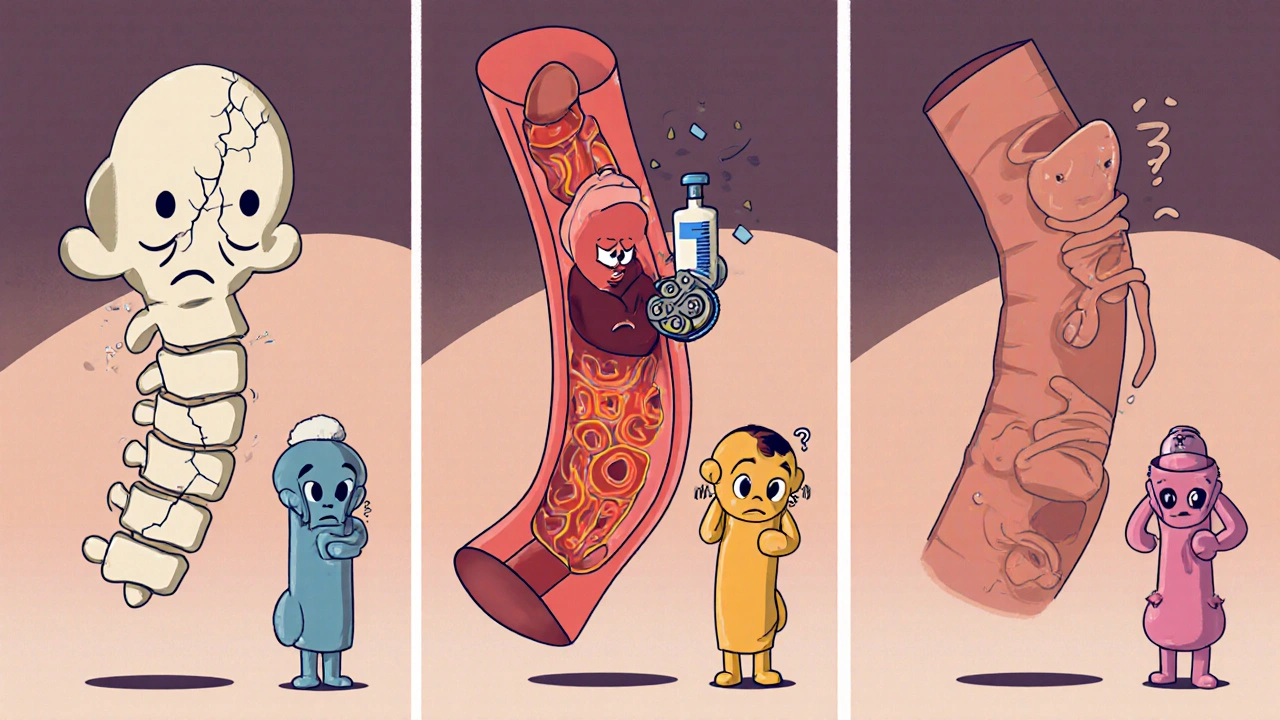Calcitriol Deficiency Risk Calculator
Calculate Your Risk
Enter your serum calcitriol level (in pg/mL) to see potential risk increases for chronic conditions.
Normal Range
Normal calcitriol levels: 30-70 pg/mL
Deficiency risk increases when levels fall below 30 pg/mL
How this works: For every 10 pg/mL decrease below 30 pg/mL, the risk increases by the percentage shown for each condition.
Estimated Risk Increases
Important Note: This calculator uses data from the article to show relative risk increases. Individual risk depends on multiple factors.
Ever wonder why a tiny hormone in your blood can influence heart attacks, bone fractures, and even auto‑immune flare‑ups? The answer lies in calcitriol deficiency. When the active form of vitamin D drops, a cascade of hormonal shifts begins, and many chronic conditions can sneak in.
What is Calcitriol?
Calcitriol is the hormonally active metabolite of vitamin D, chemically known as 1,25‑dihydroxyvitamin D3. It is produced primarily in the kidneys after two hydroxylation steps: first in the liver (forming 25‑hydroxyvitamin D) and then in the renal proximal tubules. Though it circulates at nanomolar concentrations, its influence stretches far beyond calcium absorption.
How Calcitriol Controls Calcium Homeostasis
Calcium is the backbone of bones, muscle contraction, and nerve signaling. Calcium homeostasis hinges on a delicate balance between intestinal uptake, renal reabsorption, and bone remodeling. Calcitriol boosts intestinal calcium absorption by up‑regulating the expression of calcium‑binding proteins such as calbindin.
When calcium levels dip, the parathyroid glands release Parathyroid hormone (PTH). PTH signals the kidneys to convert more 25‑hydroxyvitamin D into calcitriol, creating a feedback loop that restores serum calcium.
Beyond Bones: Calcitriol’s Role in the Immune System
Calcitriol also talks to immune cells. It binds to the vitamin D receptor (VDR) on monocytes, dendritic cells, and T‑lymphocytes, steering them toward a more tolerogenic (anti‑inflammatory) profile. This immunomodulation helps keep auto‑immune attacks in check and reduces chronic low‑grade inflammation, a common thread in many long‑term illnesses.

Chronic Diseases Tied to Low Calcitriol Levels
Research over the past decade has linked calcitriol deficiency to a handful of high‑impact chronic conditions. Below, each disease is broken down with the underlying mechanisms and the strength of current evidence.
Osteoporosis and Fragile Bones
Without enough calcitriol, the gut can’t absorb calcium efficiently, forcing the body to leach calcium from bone. Studies show that post‑menopausal women with low serum calcitriol have a 1.8‑fold higher risk of vertebral fractures.
Cardiovascular Disease (CVD)
Calcitriol suppresses the renin‑angiotensin system, a key driver of hypertension. Low levels are associated with higher blood pressure, arterial stiffness, and an increased chance of myocardial infarction. Meta‑analyses suggest a 12% rise in CVD events per 10 pg/mL drop in calcitriol.
Type 2 Diabetes Mellitus
Vitamin D receptors are present on pancreatic β‑cells. Calcitriol enhances insulin secretion and improves insulin sensitivity in muscle tissue. Cohort studies report that deficient individuals are 23% more likely to develop type 2 diabetes over five years.
Auto‑immune Disorders (e.g., Multiple Sclerosis, Rheumatoid Arthritis)
By nudging dendritic cells toward a tolerogenic state, calcitriol reduces the activation of autoreactive T‑cells. In high‑latitude regions where sunlight exposure is limited, the prevalence of multiple sclerosis rises, correlating with lower calcitriol production.
Chronic Kidney Disease (CKD) Progression
Ironically, the kidneys are where calcitriol is made. Early CKD reduces this conversion, driving a vicious cycle: low calcitriol → secondary hyper‑parathyroidism → further kidney damage. Careful management of calcitriol levels can slow the decline in glomerular filtration rate.
Evidence Snapshot: Which Diseases Have the Strongest Link?
| Chronic Disease | Observed Risk Increase | Evidence Grade |
|---|---|---|
| Osteoporosis | +80% fracture risk | High (multiple RCTs) |
| Cardiovascular Disease | +12% events per 10 pg/mL drop | Moderate (large cohort studies) |
| Type 2 Diabetes | +23% incidence | Moderate (prospective cohorts) |
| Multiple Sclerosis | +30% prevalence in low‑sunlight zones | Low‑Moderate (ecological data) |
| Chronic Kidney Disease | Accelerated GFR decline | High (interventional trials) |
How to Assess Calcitriol Status
- Order a serum 25‑hydroxyvitamin D test - this is the best proxy for vitamin D stores.
- If 25‑OH D is low (<20 ng/mL), your doctor may request a direct calcitriol measurement, especially in CKD or hyper‑parathyroid patients.
- Check related labs: calcium, phosphate, PTH, and renal function to see the whole hormonal picture.

Practical Ways to Replenish Calcitriol
- Sunlight exposure: 10‑15 minutes of midday sun on face and arms, 2-3 times a week, is enough for most adults in the UK during summer months.
- Dietary sources: Fatty fish (salmon, mackerel), egg yolks, and fortified dairy provide the vitamin D precursor.
- Supplementation: Vitamin D3 (cholecalciferol) 1,000-2,000 IU daily is safe for most adults. In cases of malabsorption or CKD, prescribe active calcitriol (0.25‑0.5 µg) under medical supervision.
- Lifestyle tweaks: Weight‑bearing exercise boosts bone density, while a low‑sodium diet supports blood pressure control, both synergistic with adequate calcitriol.
Common Pitfalls and How to Avoid Them
Even well‑meaning readers stumble into traps:
- Assuming any vitamin D supplement raises calcitriol: Only the active form bypasses the kidney step. People with severe kidney disease need the active analogue.
- Over‑supplementing: Excess vitamin D can cause hyper‑calcemia, leading to kidney stones and vascular calcification. Keep serum calcium <10.2 mg/dL.
- Neglecting seasonal variation: UK winters drastically cut UV‑B exposure; consider higher supplement doses from October to March.
- Ignoring drug interactions: Anticonvulsants and glucocorticoids increase vitamin D metabolism, raising the risk of deficiency.
Bottom Line
Calcitriol might sound like a niche hormone, but its ripple effects touch bone, heart, pancreas, and the immune system. Keeping its levels in the optimal range is a low‑cost, high‑impact strategy to fend off several chronic diseases. Regular testing, sensible sun exposure, a vitamin‑D‑rich diet, and targeted supplementation when needed can make a tangible difference to long‑term health.
What blood test tells me if I’m low in calcitriol?
The first step is a 25‑hydroxyvitamin D test. If that’s low, a doctor may order a direct calcitriol (1,25‑dihydroxyvitamin D) measurement, especially if you have kidney disease or unexplained calcium problems.
Can I get enough calcitriol from food alone?
Food provides the vitamin D precursor, not calcitriol itself. Fatty fish, egg yolks, and fortified foods boost your stores, but the final activation step still depends on sunlight and kidney health.
Is calcitriol supplementation safe for everyone?
Active calcitriol should only be prescribed when kidneys can’t convert vitamin D, such as in advanced CKD. For most people, regular vitamin D3 supplements are sufficient and safer.
How quickly can I see health improvements after fixing deficiency?
Bone‑related markers improve within 3‑6 months, while blood‑pressure benefits may appear in 8‑12 weeks. Metabolic gains, like better insulin sensitivity, often need 4‑6 months of consistent repletion.
What lifestyle changes boost my calcitriol levels besides supplements?
Aim for regular midday sun exposure when possible, keep a balanced diet rich in vitamin D foods, stay active with weight‑bearing exercise, and manage medications that speed up vitamin D breakdown.

Oliver Johnson
October 22, 2025 AT 14:58People love to shout about “vitamin D cures everything,” but the truth is a lot more messy than that hype. The hormone you call calcitriol is only one piece of a huge endocrine puzzle that governments love to simplify for headlines. If you think sprinkling sunshine on the population will fix heart attacks, think again – it’s a distraction from real policy failures. Remember, the real battle is about access to proper testing and treatment, not marketing slogans.
Taylor Haven
October 31, 2025 AT 21:11It is a moral outrage that the pharmaceutical elite have quietly suppressed the true importance of calcitriol while pushing cheap supplements that do nothing for real health. They hide behind the curtain of “standard of care” to keep the public ignorant of how a simple hormone can dictate the fate of our arteries, bones, and immune systems. The evidence they present is carefully cherry‑picked, omitting studies that show a clear link between low calcititol and cardiovascular mortality. Every headline about vitamin D’s “limited impact” is a testament to the coordinated effort of big pharma and governmental agencies to maintain control over our medical choices. Those who demand transparency are labeled “conspiracy theorists,” yet they are merely exposing the inconvenient truth. The hidden agenda extends beyond profit; it is about the power to dictate what we eat, how we live, and which illnesses we are allowed to acknowledge. When doctors prescribe synthetic analogues without mentioning the natural hormone, they are complicit in a system that monetizes disease. Their moral failing is not just academic – it translates into millions of needless heart attacks and fractures that could have been avoided with proper calcitriol management. The public’s trust is eroded each time a study is retracted for “conflict of interest,” a phrase that has become a polite way of saying “they were paid to lie.” Moreover, the media’s obsession with sensational headlines distracts us from the steady, quiet work of correcting calcium homeostasis. The truth is that calcitriol deficiency is not a fringe issue, it is a widespread crisis hidden in plain sight. It is incumbent upon us, the informed citizens, to demand full disclosure of all research data and to push for unbiased guidelines. Only then can we break the cycle of dependency on pharmaceutical fixes that merely mask symptoms. The moral imperative to act is clear, and the time for complacency has passed. We must hold the system accountable before another generation pays the price for this calculated neglect.
Sireesh Kumar
November 10, 2025 AT 03:24While you’re busy sounding the alarm, the biochemical pathway is actually straightforward: the kidney’s 1‑α‑hydroxylase converts 25‑OH‑vitamin D into calcitriol under PTH stimulation. This conversion is tightly regulated by calcium, phosphate, and fibroblast growth factor‑23, so any disturbance reflects broader metabolic imbalance. Studies using LC‑MS/MS have quantified serum calcitriol levels down to picomolar accuracy, revealing that many so‑called “deficiencies” are laboratory artifacts. Moreover, randomized trials that supplemented with calcitriol versus placebo consistently show modest reductions in systolic blood pressure, supporting a causal role. It’s also worth noting that genetic polymorphisms in the VDR can modulate individual response, which explains variability across populations. Bottom line: the science is nuanced, not a grand conspiracy.
Kelly Brammer
November 19, 2025 AT 09:38It is ethically indefensible to overlook the societal burden imposed by calcitriol deficiency, especially when preventive measures are readily available. Public health policies must prioritize routine screening for vitamin D status and ensure equitable access to supplementation for at‑risk groups. Failure to act contravenes our collective responsibility to safeguard the well‑being of vulnerable populations. The data presented in the article underscores an urgent need for evidence‑based interventions. Consequently, policymakers should allocate resources toward education and affordable treatment options.
Ben Collins
November 28, 2025 AT 15:51Wow, that was a masterclass in “just‑the‑facts” – thanks for the chemistry refresher, Dr. Know‑It‑All. I guess we’ll all just sit around waiting for our kidneys to magically wake up and do their job. Meanwhile, the rest of us are stuck trying to figure out if a sunny vacation counts as “supplementation.”
Denver Bright
December 7, 2025 AT 22:04Interesting point, but you might be ignoring the fact that many communities simply don’t have the infrastructure for widespread testing, so the “ethical” call you make feels a bit out of touch with ground realities. Perhaps a more pragmatic approach would consider mobile clinics or community health workers rather than just urging policymakers. Just saying.